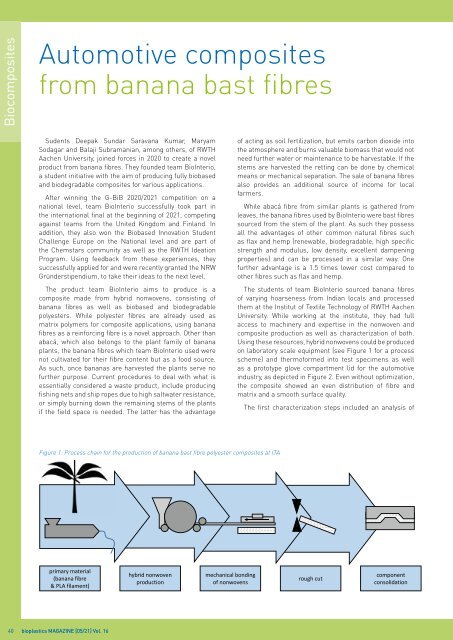issue 05/2021
Highlights: Fibres, Textiles, Nonwovens Biocomposites Basics: CO2-based plastics
Highlights:
Fibres, Textiles, Nonwovens
Biocomposites
Basics: CO2-based plastics
Create successful ePaper yourself
Turn your PDF publications into a flip-book with our unique Google optimized e-Paper software.
Biocomposites<br />
Automotive composites<br />
from banana bast fibres<br />
Sudents Deepak Sundar Saravana Kumar, Maryam<br />
Sodagar and Balaji Subramanian, among others, of RWTH<br />
Aachen University, joined forces in 2020 to create a novel<br />
product from banana fibres. They founded team BioInterio,<br />
a student initiative with the aim of producing fully biobased<br />
and biodegradable composites for various applications.<br />
After winning the G-BiB 2020/<strong>2021</strong> competition on a<br />
national level, team BioInterio successfully took part in<br />
the international final at the beginning of <strong>2021</strong>, competing<br />
against teams from the United Kingdom and Finland. In<br />
addition, they also won the Biobased Innovation Student<br />
Challenge Europe on the National level and are part of<br />
the Chemstars community as well as the RWTH Ideation<br />
Program. Using feedback from these experiences, they<br />
successfully applied for and were recently granted the NRW<br />
Gründerstipendium, to take their ideas to the next level.<br />
The product team BioInterio aims to produce is a<br />
composite made from hybrid nonwovens, consisting of<br />
banana fibres as well as biobased and biodegradable<br />
polyesters. While polyester fibres are already used as<br />
matrix polymers for composite applications, using banana<br />
fibres as a reinforcing fibre is a novel approach. Other than<br />
abacá, which also belongs to the plant family of banana<br />
plants, the banana fibres which team BioInterio used were<br />
not cultivated for their fibre content but as a food source.<br />
As such, once bananas are harvested the plants serve no<br />
further purpose. Current procedures to deal with what is<br />
essentially considered a waste product, include producing<br />
fishing nets and ship ropes due to high saltwater resistance,<br />
or simply burning down the remaining stems of the plants<br />
if the field space is needed. The latter has the advantage<br />
of acting as soil fertilization, but emits carbon dioxide into<br />
the atmosphere and burns valuable biomass that would not<br />
need further water or maintenance to be harvestable. If the<br />
stems are harvested the retting can be done by chemical<br />
means or mechanical separation. The sale of banana fibres<br />
also provides an additional source of income for local<br />
farmers.<br />
While abacá fibre from similar plants is gathered from<br />
leaves, the banana fibres used by BioInterio were bast fibres<br />
sourced from the stem of the plant. As such they possess<br />
all the advantages of other common natural fibres such<br />
as flax and hemp (renewable, biodegradable, high specific<br />
strength and modulus, low density, excellent dampening<br />
properties) and can be processed in a similar way. One<br />
further advantage is a 1.5 times lower cost compared to<br />
other fibres such as flax and hemp.<br />
The students of team BioInterio sourced banana fibres<br />
of varying hoarseness from Indian locals and processed<br />
them at the Institut of Textile Technology of RWTH Aachen<br />
University. While working at the institute, they had full<br />
access to machinery and expertise in the nonwoven and<br />
composite production as well as characterization of both.<br />
Using these resources, hybrid nonwovens could be produced<br />
on laboratory scale equipment (see Figure 1 for a process<br />
scheme) and thermoformed into test specimens as well<br />
as a prototype glove compartment lid for the automotive<br />
industry, as depicted in Figure 2. Even without optimization,<br />
the composite showed an even distribution of fibre and<br />
matrix and a smooth surface quality.<br />
The first characterization steps included an analysis of<br />
Figure 1: Process chain for the production of banana bast fibre polyester composites at ITA<br />
primary material<br />
(banana fibre<br />
& PLA filament)<br />
hybrid nonwoven<br />
production<br />
mechanical bonding<br />
of nonwovens<br />
rough cut<br />
component<br />
consolidation<br />
40 bioplastics MAGAZINE [<strong>05</strong>/21] Vol. 16

















